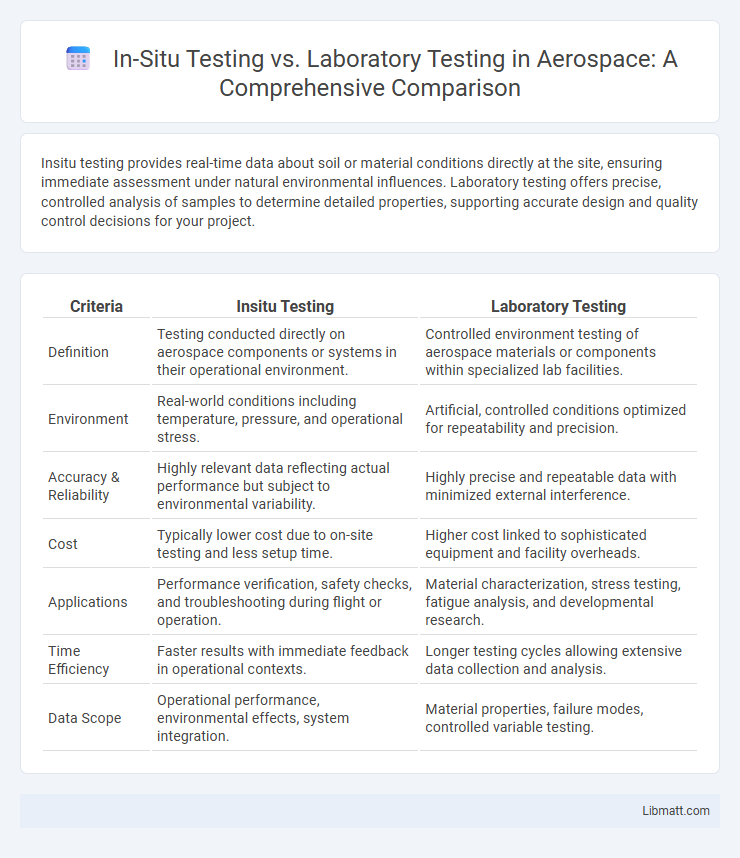Insitu testing provides real-time data about soil or material conditions directly at the site, ensuring immediate assessment under natural environmental influences. Laboratory testing offers precise, controlled analysis of samples to determine detailed properties, supporting accurate design and quality control decisions for your project.
Table of Comparison
| Criteria | Insitu Testing | Laboratory Testing |
|---|---|---|
| Definition | Testing conducted directly on aerospace components or systems in their operational environment. | Controlled environment testing of aerospace materials or components within specialized lab facilities. |
| Environment | Real-world conditions including temperature, pressure, and operational stress. | Artificial, controlled conditions optimized for repeatability and precision. |
| Accuracy & Reliability | Highly relevant data reflecting actual performance but subject to environmental variability. | Highly precise and repeatable data with minimized external interference. |
| Cost | Typically lower cost due to on-site testing and less setup time. | Higher cost linked to sophisticated equipment and facility overheads. |
| Applications | Performance verification, safety checks, and troubleshooting during flight or operation. | Material characterization, stress testing, fatigue analysis, and developmental research. |
| Time Efficiency | Faster results with immediate feedback in operational contexts. | Longer testing cycles allowing extensive data collection and analysis. |
| Data Scope | Operational performance, environmental effects, system integration. | Material properties, failure modes, controlled variable testing. |
Introduction to Insitu and Laboratory Testing
Insitu testing involves evaluating soil, rock, or materials directly at the site to obtain real-time data reflecting natural conditions, such as Standard Penetration Tests (SPT) and Cone Penetration Tests (CPT). Laboratory testing requires collecting samples from the field and analyzing them under controlled conditions to determine physical and mechanical properties, including grain size distribution, Atterberg limits, and unconfined compressive strength. Both methods are essential in geotechnical engineering, with insitu testing providing immediate insights and laboratory testing offering detailed, precise material characterization.
Definitions and Key Concepts
Insitu testing involves evaluating soil or materials directly at the site, providing real-time data on their natural properties and behavior under existing conditions. Laboratory testing requires extracting samples to analyze in controlled environments, offering precise measurements of physical and chemical characteristics. Your choice between these methods depends on the need for immediate field insights versus detailed, controlled analysis.
Advantages of Insitu Testing
In situ testing offers real-time soil and material assessment directly at the construction site, providing immediate and accurate data that reflects actual ground conditions without sample disturbance. This method reduces uncertainties linked to soil heterogeneity and eliminates delays and costs associated with sample transportation and laboratory processing. Insitu testing techniques such as cone penetration tests (CPT) and standard penetration tests (SPT) enhance construction safety and design precision by delivering continuous profiles of soil stratigraphy and properties.
Advantages of Laboratory Testing
Laboratory testing offers precise control over environmental variables, enabling consistent and repeatable results essential for accurate material characterization. It allows for comprehensive analysis using advanced equipment that may not be feasible onsite, providing detailed insights into soil properties, chemical composition, and structural strength. Your project benefits from the reliability and standardized protocols of laboratory testing, which support critical decision-making in engineering and construction.
Limitations of Insitu Testing
Insitu testing often faces limitations such as restricted control over environmental conditions, which can lead to variable and less precise results compared to laboratory testing. The inability to replicate standardized stress conditions limits the accuracy and repeatability of insitu test data. Additionally, insitu testing may be constrained by site accessibility and logistical challenges, impacting comprehensive data collection and interpretation.
Limitations of Laboratory Testing
Laboratory testing often fails to replicate the complex environmental conditions present in situ, leading to results that may not accurately reflect real-world soil behavior. The disturbance caused by sample extraction and transportation can alter the soil's natural state, affecting the test outcomes and reducing reliability. Your geotechnical analysis benefits from considering the limitations of laboratory testing alongside in-situ methods to achieve a more comprehensive understanding of soil properties.
Comparison of Accuracy and Reliability
In situ testing offers real-time data reflecting actual field conditions, enhancing accuracy for site-specific assessments, whereas laboratory testing provides controlled environments that yield highly reliable and repeatable results. Variability in site conditions can affect in situ test outcomes, while laboratory testing minimizes external influences, ensuring consistent accuracy. Your choice depends on balancing the need for immediate, location-specific data with the precision and reliability of standardized laboratory methods.
Cost and Time Considerations
In situ testing typically reduces time and costs by allowing immediate data collection on-site without the need for sample transportation or preparation, accelerating project timelines. Laboratory testing often incurs higher expenses due to sample handling, specialized equipment, and extended processing periods, increasing project budgets and delays. Choosing between the two methods depends on project urgency, budget constraints, and the required accuracy of geotechnical or construction analysis.
Applications in Geotechnical Engineering
Insitu testing in geotechnical engineering provides real-time data on soil properties directly at the site, making it ideal for assessing foundation bearing capacity, soil stratigraphy, and in-situ stress conditions. Laboratory testing is essential for detailed analysis of soil samples to determine grain size distribution, Atterberg limits, and shear strength under controlled conditions, which supports more precise design parameters. Your choice between insitu and laboratory testing depends on project requirements, site conditions, and the need for immediate versus detailed geotechnical data.
Choosing the Right Testing Method
Selecting the appropriate testing method depends on project requirements, site conditions, and accuracy needs. Insitu testing offers real-time data on soil behavior under actual field conditions, making it ideal for preliminary site assessments and foundation design. Laboratory testing provides controlled environments to analyze soil samples for detailed geotechnical properties, essential for complex engineering evaluations and design validation.
Insitu Testing vs Laboratory Testing Infographic

 libmatt.com
libmatt.com